Digitization has become an essential feature for the resilience of our societies in the fast few decades: it has proven to be indispensable in 2020, at the peak of the Covid-19 crisis, and its importance in our lives will certainly keep growing in the years to come.
However, the environmental impact of digital activities is increasingly harder to ignore. Digital technologies are responsible for 4% of greenhouse gas emissions worldwide, and their energy consumption is growing by 9% each year. Among these emissions, around 15% are caused by the energy consumption of data centers – the rest are mainly caused by user terminals (63%) and networks (22%)[1].
Although data centers represent a relatively minor part of carbon emissions in digital activities, they can become a significant weight on the carbon footprint of companies. Some infrastructure choices may also have a direct impact on the company's carbon footprint: is it better to have an on-premise infrastructure? Which cloud provider is the most advanced in reducing and communicating their carbon emissions?
Here are five key points to help you see things more clearly about this topic.
1. Why does cloud computing emit greenhouse gases?
In order to properly understand the carbon emissions related to data centers, we must first get to the root of what cloud computing actually entails. Behind the numerous use cases – including web hosting, data storage, machine learning, or other intensive computing applications … – there is one basic, fundamental principle: customers purchase the ability to offload their computing workload to remote data centers instead of using their own on-premise infrastructure. This way, they benefit from more flexibility.

General overview of cloud services. Generally speaking, cloud service providers allow their customers to store data, make queries, run heavy computations, and host websites, and applications, …
Carbon emissions related to cloud computing can therefore be divided into four big categories[2].
The electricity consumption of servers. This is the first thing that comes to mind. The electricity generation can be more or less carbonated, depending on the cloud location, and the choices made by cloud service providers. On the whole, data centers demand a lot of energy to work: in 2020, data centers around the world used around 200 TWh, which represents 1% of the global electricity demand.
The energy used for server cooling. When under load, servers tend to heat up, so they need to be cooled down to sustain continuous use – usually with fans, or a water cooling system. This dimension is tracked with a ratio called the Power Usage Effectiveness (PUE), which tells how much energy needs to be spent on cooling for the servers to work correctly. For example, a PUE of 2 means that for each kWh consumed by a server, one kWh must be spent on cooling.
The manufacturing of servers and cooling equipment. Building this equipment requires extracting rare metals and other raw materials, a multitude of intermediary industrial processes, and shipping from the factory to the data center. All those steps require a significant amount of energy, which directly translates into CO2 emissions.
Emissions are caused by employees working in the data centers – although this is usually the smallest source of emissions. This category may include their commute, the personal computers they use, their meals, …
In other words, in order to compute the carbon emissions of the cloud services that you purchase, it is necessary to have a proper estimation of all of those parameters.
2. Cloud services are more efficient than on-premise servers
From a carbon point of view, cloud computing is usually less emissive than an average on-premise infrastructure.
Their workload is more optimized: there is less need to have extra machines “just in case”, to deal with random bursts of activity. Because of their size, cloud providers are able to distribute the workload a lot more efficiently, thereby needing fewer machines.
Their cooling system is much more efficient as well. Because of the direct impact on their costs, and because it is part of their core business, cloud providers have a strong incentive to spend as little energy as possible on cooling.
This assumes that you pick an instance in a country where the electricity generation does not emit a lot of CO2. If you are unsure, you may check the carbon intensity of your country with electricityMap, an open-source project which tracks in real-time the carbon intensity of electricity consumed in most European, American, and Oceanic countries.
The use of cloud computing has been one of the key instruments to limit the growth in energy use of digital industries. According to the International Energy Agency (IEA), data center workloads have grown ten-fold between 2010 and 2020, yet data center energy use has remained extremely stable over the same period.
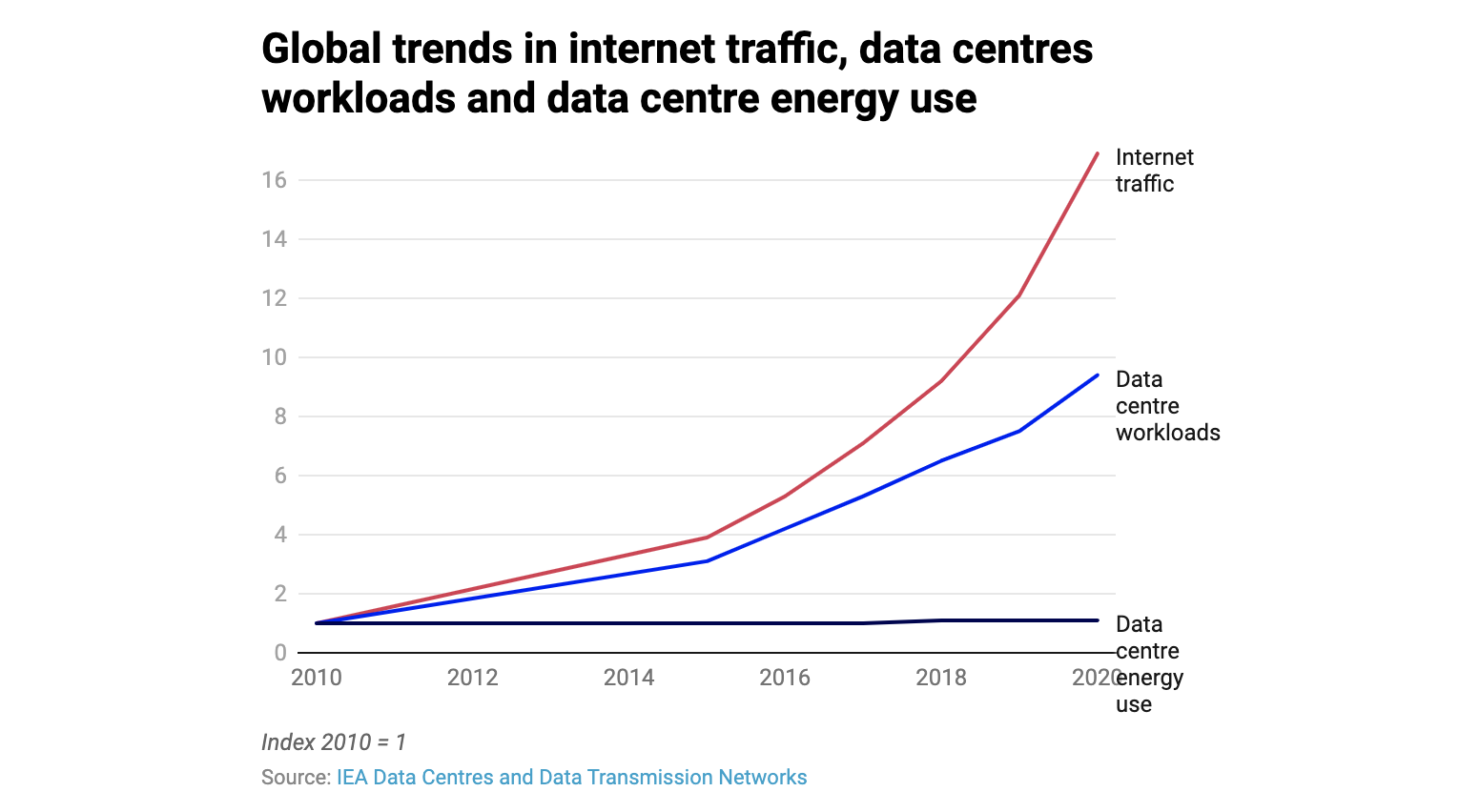
3. The distributed nature of cloud computing requires emissions allocation
Cloud computing services may be more efficient than on-premise infrastructures on an aggregate level, but they make it much more difficult to allocate carbon emissions to individual customers.
One of the advantages of cloud computing over an on-premise infrastructure is its “plug-and-play” nature. Customers purchase services, not servers: they do not have to purchase new machines, upgrade them, or manage them, so infrastructure hassle is reduced to the minimum. This is convenient because companies can spend more time focusing on their core business; on the downside, this means that they lose visibility about what they are actually getting.
This loss of visibility also affects cloud providers themselves, because of the distributed nature of cloud computing. Cloud customers purchase services, not individual servers: due to the way that large data centers operate, their workload may end up being shared across multiple servers, making it much more difficult to track. In addition to that, several layers of shared resources are necessary to coordinate all the services offered by cloud providers: reallocating those shared resources to individual customers quickly becomes a massive headache.
4. The price you pay is not a good proxy for your carbon emissions
Individual customers may lose some information about what they get, but what they do know is the price they pay for their service.
Price does not accurately reflect energy use
To get the carbon emissions generated by a cloud service, two major pieces of information are required: the energy used, and the equipment needed. This is the conclusion that can be drawn from a life cycle assessment made by Dell on one of its servers.
Half of the lifecycle emissions of a server are generated during its manufacturing process – which includes the extraction of raw materials, and a variety of energy-intensive industrial transformations,
The other half is generated during its use.
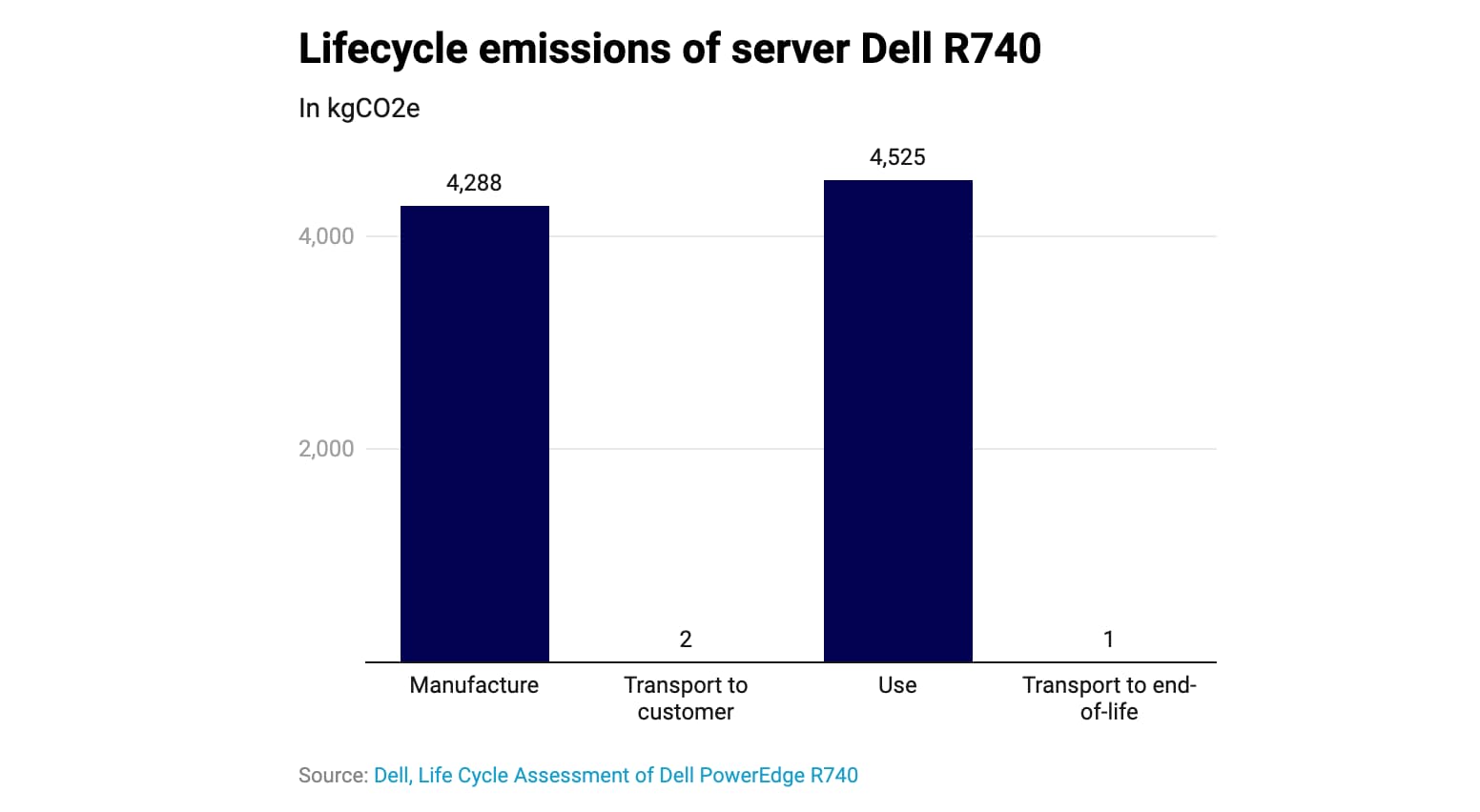
That being said, the price only gives us one piece of the puzzle. According to our internal research, electricity costs represent a surprisingly small part of total costs: server-grade CPUs and GPUs cost a lot to make, which makes the variable costs surprisingly low.

In other words, in the best scenario, the price paid for cloud computing services can only help estimate the quantity of equipment used, but it tells us very little about the emissions during the use phase.
The price depends on other external factors
The other issue is that the pricing system of cloud providers is not straightforward for the user. Aside from covering their immediate running costs, cloud service providers may also optimize their prices depending on many other factors, including the type of service used, or the time of day.
Users with predictable workflows also have a massive incentive to book cloud instances in advance: for instance, in Google Cloud, committing to using the same instance for three years may earn you a 50% cost reduction on your bill. Of course, this makes sense for cloud providers from an economic point of view, since keeping an excessive amount of idle servers “just in case” would be very costly in the long run. However, it also means that it is harder for the end consumer to know exactly what they are paying for in the end, similar costs at the end may result from a wide array of different situations, rendering them unusable to predict carbon emissions.
5. What major cloud providers are doing about it
At the time of writing this article (March 2022), all major cloud providers have started communicating with their customers about their carbon footprint, but with varying methods and intentions.
Microsoft Azure has implemented a carbon footprint calculator more than two years ago, but not all customers can access it: it seems to only be available for Power BI Pro users. Although the figures presented by Azure could be used for reporting (the internal computations follow the same structure as the GHG protocol), the main goal of this calculator is actually to communicate about emissions prevented by Azure.

Picture from the Microsoft AppSource webpage. The information about “saved” emissions appears right in the middle of the interface.
Amazon is a latecomer on this topic. Its customer carbon footprint tool was announced in December 2021, and it has just entered production mode: this calculator should now be available for all AWS customers, free of charge. However, based on their presentation, it seems that their communication has basically the same goal as Azure, which is to emphasise on emissions “saved” compared to an on-premise infrastructure.
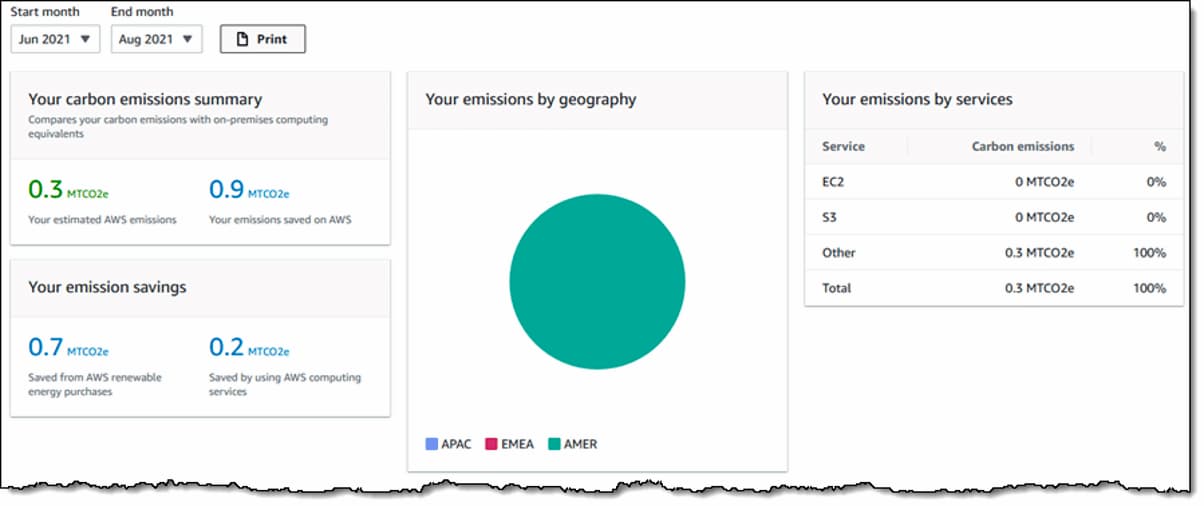
Picture from Amazon’s communication.
Note that both Azure and Amazon communicate on market-based emissions, which enables them to leverage their purchases of green electricity. This choice in methodology allows them to look even more competitive against average on-premise servers, which use the local electricity grid.
On the other hand, according to their methodology document, Google applies the location-based reporting method, so their reported emissions from electricity use are based on the local electricity grid. Their interface is much more subdued, as well: they simply communicate on the greenhouse gas that was emitted, and not on prevented emissions.
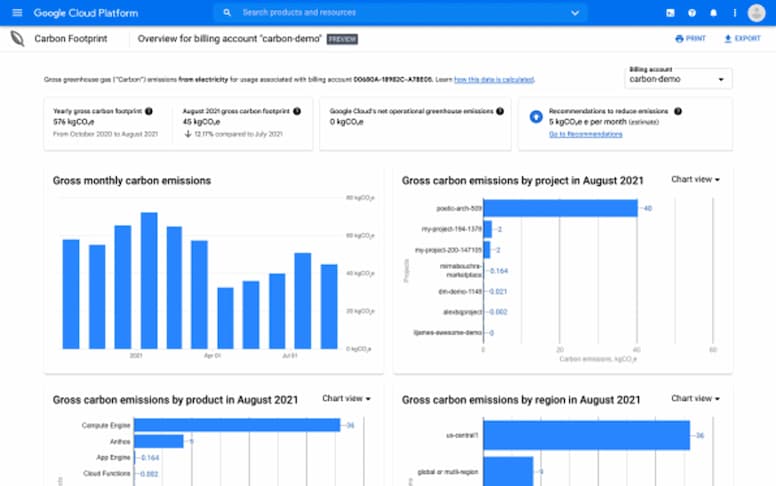
Source: Fast Company, Google Cloud wants to help your company go green.
Despite that, declared emissions from Google are not entirely comprehensive: contrary to Azure, the report excludes the manufacturing emissions of data center equipment, which can represent up to half of the total emissions caused by cloud computing.
Among other cloud providers, we want to praise OVH for their transparent reporting. Customers who wish to know their carbon footprint can ask for a report that includes the electricity consumed by the data centers, the embedded emissions of the cloud servers, as well as the emissions caused by employees who work in OVH. The report also includes some information on water usage.
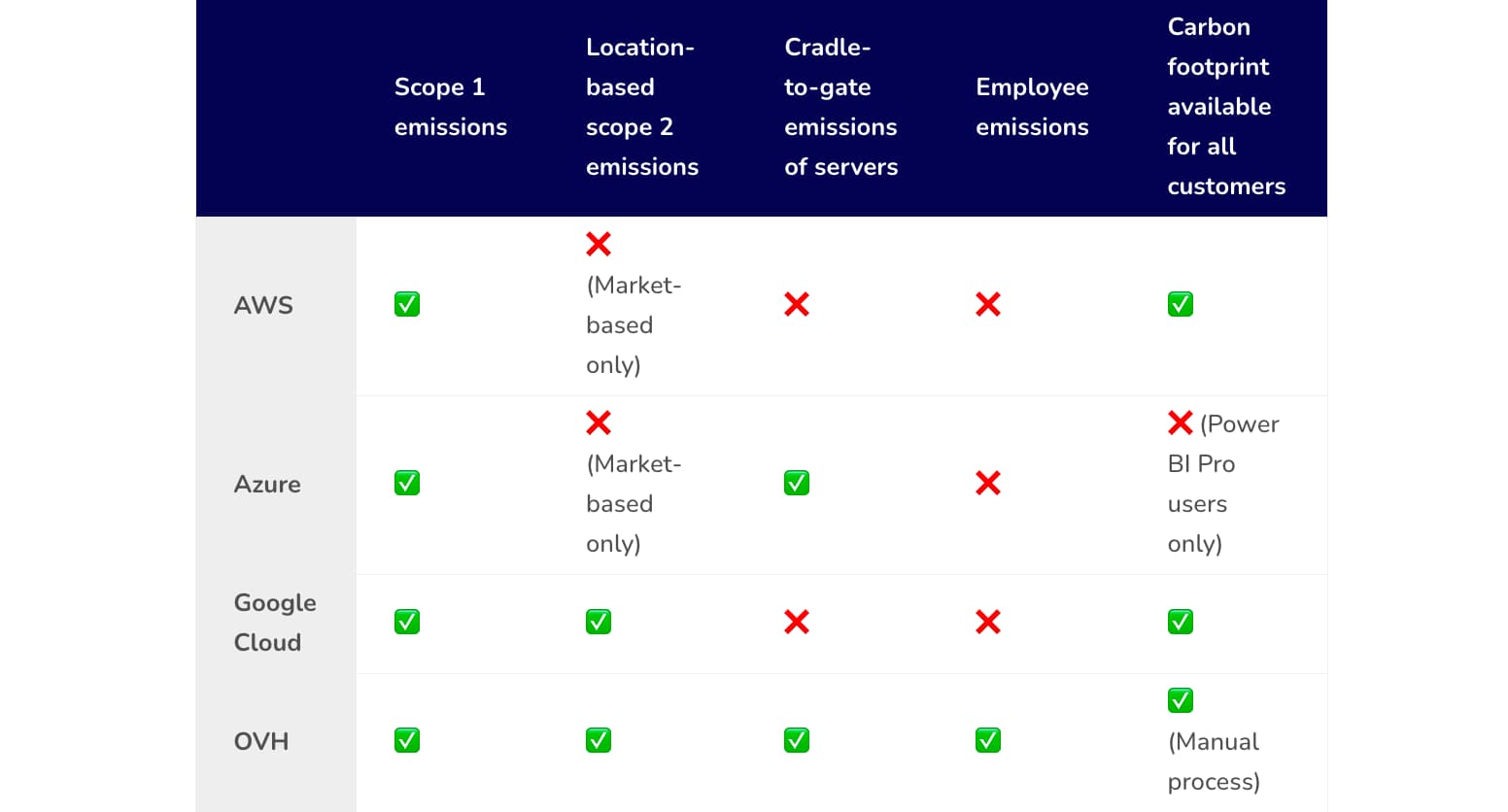
Comparison of major cloud providers on their carbon footprint calculators
Conclusion
All other things being equal, cloud computing is significantly more energy efficient than having an on-premise infrastructure: it has been one of the major reasons why the energy consumption of data centers has remained stable in the last ten years, even though the workload has been multiplied by eight in the meantime.
That being said, “stable” is not quite good enough: in order to reach the 1.5°C temperature goal set in the Paris Agreement, global emissions have to fall by 7.6 percent each year. In the end, cloud computing may be yet another application of the Jevons paradox, also called the Jevons effect or rebound effect: new technologies that allow for more efficient resource use also create new use cases, so the overall effect can be neutral, or worse.
Notes
[1] GreenIT.fr, 2019. The environmental footprint of the digital world. p.12. Available at: https://www.greenit.fr/wp-content/uploads/2019/11/GREENIT_EENM_etude_EN_accessible.pdf
[2] This article takes the point of view of a user who wants to estimate how much CO2e they emit by purchasing cloud services: in the GHG Protocol, the corresponding emissions would end up in the category 3-1 “Purchased goods and services”. For this reason, the focus will solely be on the scope 1, 2, and 3 upstream of cloud providers.
